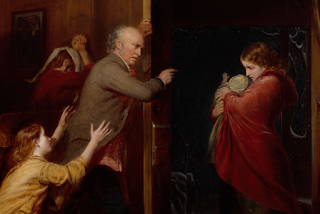Theory and the Museum
Roxanne L. Euben’s Journeys to the Other Shore: Muslim and Western Travelers in Search of Knowledge changed how I read and taught.[1] Drawing on the etymology of ‘theory’, which relates to contemplation, speculation (theōria) and ultimately spectatorship (theōros), another semantic parallel between Arabic and Greek struck me, since the Arabic, naẓariyya, likewise connects with notions of looking and speculation. That we often read and speak of theories as ‘lenses’ is appropriate, then, and here I’d like to reflect on the place of theory in museological practices and the ways that the metaphor of theory-as-seeing could be recast.
How far do theories inform how curators stage exhibitions and what place do they have for visitors? Considering the catalogues for the National Gallery’s Michelangelo and Sebastiano, the Tate Modern’s Agnes Martin and the Philadelphia Museum of Art’s Cy Twombly: Fifty Days at Iliam, they present and build upon theoretical bases.[2] Carlos Basualdo for instance claims that history painting is very much alive in Cy Twombly’s work, while Costanza Barbieri puts forward a tantalising interpretation of the Viterbo Pietà. These were exhibitions undoubtedly founded upon serious contemplation and intellectual synthesis, but what about visitors’ reactions to these? Are we supposed to perceive them in our communion with the works, or to explicitly learn about them from labels and catalogues in order to weigh them up vis-à-vis the exhibited pieces and whatever other works we deem relevant to bring to bear?
It’s frequently discussed that we’ve privileged the eye and, given the multifariousness of contemporary art practices (encompassing sound arts, interaction, performance and multimedia among myriad others) perhaps we need not worry that vision reigns supreme. There will always be an informed guide, sceptical article or the mysteriousness of the work to coax us away from an habituated focusing (another visual metaphor) with the eyes to an enhanced sensory engagement and redirection of our attention. The benefits for ourselves would hopefully radiate into our modes of communication, including teaching, with others.
[1] Roxanne L. Euben, Journeys to the Other Shore: Muslim and Western Travelers in Search of Knowledge (Princeton, NJ; Woodstock, UK: Princeton University Press, 2006).
[2] Matthias Wivel and others, Michelangelo and Sebastiano (London: National Gallery, 2017); Frances Morris and Tiffany Bell (eds), Agnes Martin (London: Tate, 2015); Carlos Basualdo (ed.), Cy Twombly: Fifty Days at Iliam (n.p.: Yale University Press, 2017).

Comments
Post a Comment